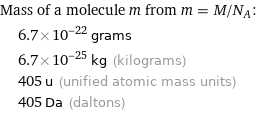Input interpretation

tin(II) 2-ethylhexanoate | molar mass
Result
![Find the molar mass, M, for tin(II) 2-ethylhexanoate: M = sum _iN_im_i Plan: • Write the chemical formula and gather atomic masses from the periodic table. • Determine values for N_i and m_i using these items. • Finally, compute the mass. Write the chemical formula: [CH_3(CH_2)_3CH(C_2H_5)CO_2]_2Sn Use the chemical formula to count the number of atoms, N_i, for each element: | N_i C (carbon) | 16 H (hydrogen) | 30 O (oxygen) | 4 Sn (tin) | 1 Look up the atomic mass, m_i, in g·mol^(-1) for each element in the periodic table: | N_i | m_i/g·mol^(-1) C (carbon) | 16 | 12.011 H (hydrogen) | 30 | 1.008 O (oxygen) | 4 | 15.999 Sn (tin) | 1 | 118.710 Multiply N_i by m_i to compute the mass for each element. Then sum those values to compute the molar mass, M: Answer: | | | N_i | m_i/g·mol^(-1) | mass/g·mol^(-1) C (carbon) | 16 | 12.011 | 16 × 12.011 = 192.176 H (hydrogen) | 30 | 1.008 | 30 × 1.008 = 30.240 O (oxygen) | 4 | 15.999 | 4 × 15.999 = 63.996 Sn (tin) | 1 | 118.710 | 1 × 118.710 = 118.710 M = 192.176 g/mol + 30.240 g/mol + 63.996 g/mol + 118.710 g/mol = 405.122 g/mol](../image_source/b5fc1d4f1e7a22ffbfa8288754bd5d3f.png)
Find the molar mass, M, for tin(II) 2-ethylhexanoate: M = sum _iN_im_i Plan: • Write the chemical formula and gather atomic masses from the periodic table. • Determine values for N_i and m_i using these items. • Finally, compute the mass. Write the chemical formula: [CH_3(CH_2)_3CH(C_2H_5)CO_2]_2Sn Use the chemical formula to count the number of atoms, N_i, for each element: | N_i C (carbon) | 16 H (hydrogen) | 30 O (oxygen) | 4 Sn (tin) | 1 Look up the atomic mass, m_i, in g·mol^(-1) for each element in the periodic table: | N_i | m_i/g·mol^(-1) C (carbon) | 16 | 12.011 H (hydrogen) | 30 | 1.008 O (oxygen) | 4 | 15.999 Sn (tin) | 1 | 118.710 Multiply N_i by m_i to compute the mass for each element. Then sum those values to compute the molar mass, M: Answer: | | | N_i | m_i/g·mol^(-1) | mass/g·mol^(-1) C (carbon) | 16 | 12.011 | 16 × 12.011 = 192.176 H (hydrogen) | 30 | 1.008 | 30 × 1.008 = 30.240 O (oxygen) | 4 | 15.999 | 4 × 15.999 = 63.996 Sn (tin) | 1 | 118.710 | 1 × 118.710 = 118.710 M = 192.176 g/mol + 30.240 g/mol + 63.996 g/mol + 118.710 g/mol = 405.122 g/mol
Unit conversion

0.40512 kg/mol (kilograms per mole)
Comparisons

≈ 0.56 × molar mass of fullerene ( ≈ 721 g/mol )

≈ 2.1 × molar mass of caffeine ( ≈ 194 g/mol )

≈ 6.9 × molar mass of sodium chloride ( ≈ 58 g/mol )
Corresponding quantities

Mass of a molecule m from m = M/N_A: | 6.7×10^-22 grams | 6.7×10^-25 kg (kilograms) | 405 u (unified atomic mass units) | 405 Da (daltons)

Relative molecular mass M_r from M_r = M_u/M: | 405